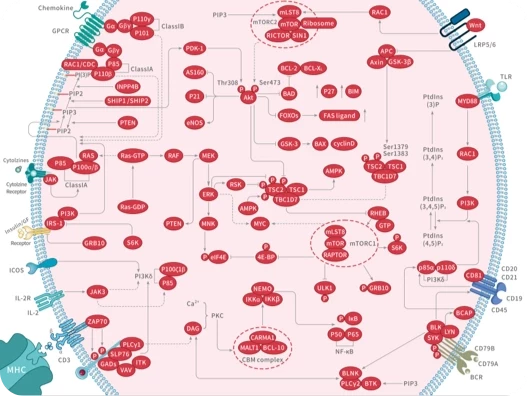- 全部删除
 您的购物车当前为空
您的购物车当前为空
SARS-CoV-2 Helicase Protein (His & MBP)
The non—structural protein 13 (nsp13) of SARS—CoV 2 is a helicase that separates double—stranded RNA or DNA with a 5'—3' polarity, using the energy of nucleotide hydrolysis. A basic biochemical characterization of nsp13 demonstrated that it can unwind both doublestranded DNA and RNA in a 5'-3' direction, and it can hydrolyze all deoxyribonucleotide and ribonucleotide triphosphates. Helicases are motor proteins that utilize the energy derived from nucleotide hydrolysisto unwind double-stranded nucleic acids into two single-stranded nucleic acids. Initially, helicases were only thought to be molecular engines that unwind nucleic acids during replication, recombination, and DNA repair. Recent studies have shown that they are also involved in other biological processes, including displacement of proteins from nucleic acid, movement of Holliday junctions, chromatin remodeling, catalysis of nucleic acid conformational changes, several aspects of RNA metabolism, including transcription, mRNA splicing, mRNA export, translation, RNA stability and mitochondrial gene expression. Some human diseases, including Bloom's syndrome, Werner's syndrome, and Xeroderma Pigmentosum have been associated with defects in helicase function.

SARS-CoV-2 Helicase Protein (His & MBP)
| 规格 | 价格 | 库存 | 数量 |
|---|---|---|---|
| 10 μg | ¥ 980 | 5日内发货 | |
| 50 μg | ¥ 2,960 | 5日内发货 | |
| 500 μg | ¥ 15,800 | 5日内发货 | |
| 1 mg | ¥ 23,700 | 5日内发货 |
产品信息
| 生物活性 | Activity has not been tested. It is theoretically active, but we cannot guarantee it. If you require protein activity, we recommend choosing the eukaryotic expression version first. |
| 产品描述 | The non—structural protein 13 (nsp13) of SARS—CoV 2 is a helicase that separates double—stranded RNA or DNA with a 5'—3' polarity, using the energy of nucleotide hydrolysis. A basic biochemical characterization of nsp13 demonstrated that it can unwind both doublestranded DNA and RNA in a 5'-3' direction, and it can hydrolyze all deoxyribonucleotide and ribonucleotide triphosphates. Helicases are motor proteins that utilize the energy derived from nucleotide hydrolysisto unwind double-stranded nucleic acids into two single-stranded nucleic acids. Initially, helicases were only thought to be molecular engines that unwind nucleic acids during replication, recombination, and DNA repair. Recent studies have shown that they are also involved in other biological processes, including displacement of proteins from nucleic acid, movement of Holliday junctions, chromatin remodeling, catalysis of nucleic acid conformational changes, several aspects of RNA metabolism, including transcription, mRNA splicing, mRNA export, translation, RNA stability and mitochondrial gene expression. Some human diseases, including Bloom's syndrome, Werner's syndrome, and Xeroderma Pigmentosum have been associated with defects in helicase function. |
| 种属 | SARS-CoV-2 |
| 表达系统 | E. coli |
| 标签 | C-6xHis |
| 蛋白编号 | P0DTD1 |
| 别名 | SARS-CoV 2 nsp13,SARS-CoV 2 Helicase |
| 氨基酸序列 | Ala5325-Gln5925 |
| 蛋白构建 | Ala5325-Gln5925 |
| 蛋白纯度 | Greater than 80% as determined by reducing SDS-PAGE. (QC verified) |
| 分子量 | 120 KDa (reducing condition) |
| 缓冲液 | Supplied as a 0.2 μm filtered solution of PBS, pH 7.4. |
| 存储 | Lyophilized powders can be stably stored for over 12 months, while liquid products can be stored for 6-12 months at -80°C. For reconstituted protein solutions, the solution can be stored at -20°C to -80°C for at least 3 months. Please avoid multiple freeze-thaw cycles and store products in aliquots. |
| 运输方式 | In general, Lyophilized powders are shipping with blue ice. Solutions are shipping with dry ice. |
| 研究背景 | The non—structural protein 13 (nsp13) of SARS—CoV 2 is a helicase that separates double—stranded RNA or DNA with a 5'—3' polarity, using the energy of nucleotide hydrolysis. A basic biochemical characterization of nsp13 demonstrated that it can unwind both doublestranded DNA and RNA in a 5’-3’ direction, and it can hydrolyze all deoxyribonucleotide and ribonucleotide triphosphates. Helicases are motor proteins that utilize the energy derived from nucleotide hydrolysisto unwind double-stranded nucleic acids into two single-stranded nucleic acids. Initially, helicases were only thought to be molecular engines that unwind nucleic acids during replication, recombination, and DNA repair. Recent studies have shown that they are also involved in other biological processes, including displacement of proteins from nucleic acid, movement of Holliday junctions, chromatin remodeling, catalysis of nucleic acid conformational changes, several aspects of RNA metabolism, including transcription, mRNA splicing, mRNA export, translation, RNA stability and mitochondrial gene expression. Some human diseases, including Bloom’s syndrome, Werner’s syndrome, and Xeroderma Pigmentosum have been associated with defects in helicase function. |








































